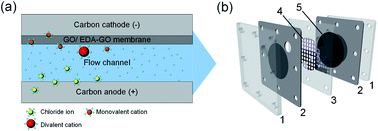Electric field modulated ion-sieving effects of graphene oxide membranes†
Abstract
Precise and selective separation of ions using two-dimensional (2D) laminar membranes is a budding research field with potential applications in water treatment, desalination, sensing, biomimicry and energy storage. However, most experiments are designed around pressure or concentration–driven processes without leveraging on the charged nature of ionic species. By applying an electric field across a 2D graphene oxide-based (GO-based) membrane, we demonstrate how ionic selectivity can be enhanced by changing the polarity or increasing the strength of the field. As opposed to traditional permeation experiments, the effects of selectivity are not limited to the membrane itself and can be dynamically tuned during ion removal by changing the strength of the applied electric field. Two types of membranes were investigated in a series of experiments using binary solutions of monovalent and divalent salts. The first is a classical, unmodified GO membrane and the second is a GO membrane with d-spacing restricted by functionalization with ethylenediamine (EDA). Monovalent ion selectivity was detected for both membranes with the EDA–GO membrane achieving a monovalent ion selectivity between 1.5–5 as compared to 1.3–3.5 for the GO membrane. Using density functional theory (DFT) calculations, we determined that the presence of EDA enhanced the formation of K+ and Na+ complexes which would cause distortions in local interlayer distances.



 Please wait while we load your content...
Please wait while we load your content...